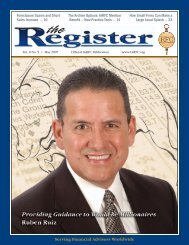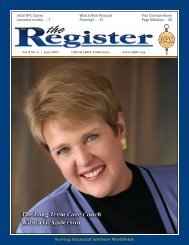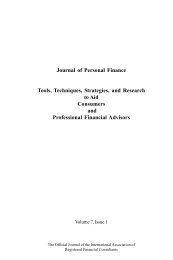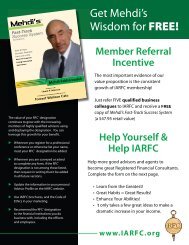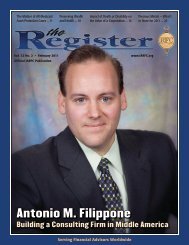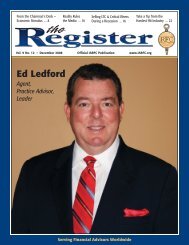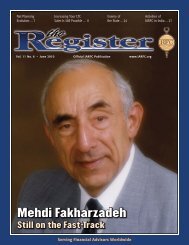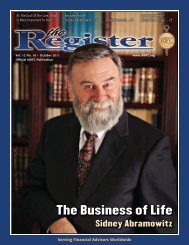Originator: Positive Mental Attitude W. Clement Stone - iarfc
Originator: Positive Mental Attitude W. Clement Stone - iarfc
Originator: Positive Mental Attitude W. Clement Stone - iarfc
You also want an ePaper? Increase the reach of your titles
YUMPU automatically turns print PDFs into web optimized ePapers that Google loves.
The Secret of Prospecting — Create A Board of Advisors<br />
I. David Cohen, CLU, ChFC, LUTCF, RFC ®<br />
At approximately 8:30 am on June 10,<br />
1958 I attended my first training session<br />
as a brand new life insurance agent. I<br />
was twenty-three and a college graduate<br />
in the school of business. The training<br />
supervisor explained the difference<br />
between whole life and term insurance.<br />
He covered everything from non-forfeiture<br />
provisions to the convertibility of term<br />
insurance. I was excited to learn so much<br />
about our products.<br />
At the end of our two hour session he<br />
asked if we had any questions. As you<br />
might expect there were the usual<br />
questions concerning the product features<br />
but no one in class asked the most<br />
important question, so I did: “Who do I<br />
sell these policies to and how do I get to<br />
them in order to have a meaningful<br />
discussion?” His response was what I<br />
later found to be the norm — we will get to<br />
that next time!<br />
As you might guess the next time never<br />
came. I quickly found that very few, if any,<br />
in our profession are truly experts on<br />
prospecting. It occurred to me from that<br />
first day that if I didn’t determine how to<br />
find prospects, all the product knowledge<br />
would mean absolutely nothing. Therefore,<br />
I decided that I was going to spend most of<br />
my efforts not on product knowledge, but<br />
on prospecting. It worked! Some 48 years<br />
later I am still here and still thriving.<br />
Action Steps. Let’s take a look at an idea<br />
that you can put into place today to<br />
enable you to sit down with qualified<br />
prospects. However, you first need to:<br />
• Identify your Target Market.<br />
• What are this market’s primary<br />
needs and wants?<br />
• Have a deep understanding of your<br />
products and services.<br />
• Understand how your products and<br />
services help your clients.<br />
Once you have identified your market the<br />
age old dilemma rears its head — how do I<br />
get to see these people and businesses<br />
under favorable circumstances?<br />
Create a Board of Advisors. Companies,<br />
universities, and non-profit organizations<br />
have boards of advisors, directors, or<br />
trustees — it’s required by law. Why? The<br />
answer is simple: accountability. After all,<br />
leaders in positions of power can not have<br />
absolute power. They must answer to<br />
someone — especially in situations where<br />
the leaders are responsible for managing<br />
assets that belong to others (such as<br />
publicly held companies and non-profit<br />
organizations).<br />
There is a process of checks and<br />
balances that occurs in effective boards<br />
which creates a sense of accountability<br />
that holds senior management’s feet to<br />
the fire. This is one important value of<br />
creating a personal board of advisors. A<br />
group of three to five (or more) centers of<br />
influence who share your vision and want<br />
to see you succeed. To this end, your<br />
advisory board should be available to<br />
give you:<br />
• Advice<br />
• Counseling<br />
• Encouragement<br />
• Pressure to follow through on<br />
your commitments<br />
To begin, ask three to five of your best,<br />
most influential clients to serve on your<br />
board. Why clients? The answer is simple<br />
— only a client can truly grasp and<br />
understand the value of what you offer.<br />
Organize to work with your board.<br />
You share your mission statement and<br />
business plan with your board. Their<br />
commitment is to meet with you as a<br />
group two to three times a year. This is<br />
not a new concept. In his book “Love The<br />
Work You’re With”, author Richard Whitely<br />
describes six key “jobs” that together can<br />
make up an effective board of advisors.<br />
Mentor.<br />
Your mentor should care about your<br />
success and have ownership in your<br />
future development.<br />
Strategist.<br />
A person who can anticipate future<br />
challenges and opportunities, and can<br />
then alert you to them.<br />
Solution Provider.<br />
Someone who would be focused on the<br />
present.<br />
Coach.<br />
It’s someone who helps you stay focused<br />
on what you need to achieve and how you<br />
are going to achieve it.<br />
Butt Kicker.<br />
He or she can motivate you to challenge<br />
yourself in ways you never imagined.<br />
Cheerleader.<br />
A person who always reinforces a positive<br />
attitude.<br />
Your board of advisors should be “elite”<br />
members of your centers of influence.<br />
They may or may not have a professional<br />
relationship with you. They can be<br />
suppliers, clients or work associates.<br />
Once you have created your board of<br />
advisors you need to make certain that<br />
each person takes their role as your<br />
advisor seriously. They need to see that<br />
you mean business. Follow these steps<br />
and I assure you that you will have plenty<br />
of qualified prospects to see!<br />
Getting leads or nominations. This will<br />
come naturally. As your board members<br />
see you grow and develop your services<br />
they will voluntarily suggest persons you<br />
should be calling upon. <br />
I. David Cohen, CLU, ChFC, LUTCF, RFC ®<br />
David has written a text book and<br />
curriculum course entitled, “Prospect or<br />
Perish”. The purpose of this effort is to<br />
help financial service professionals<br />
enhance their prospecting skills so that<br />
they can achieve the results they desire.<br />
The IARFC is planning to incorporate this<br />
into the new RFC ® course within the Client<br />
Engagement part of the curriculum. The<br />
Prospect or Perish materials have been<br />
adopted by NAIFA — Ohio as part of a<br />
program to be presented by association<br />
leaders. David has been a member of<br />
MDRT since 1962 and has been a<br />
popular instructor of LUTCF and estate<br />
planning programs. You can obtain his<br />
book or inquire about instructing courses<br />
in your community. Contact David at:<br />
e-mail address: rkicidc@columbus.rr.com<br />
or 614 258 0444<br />
The Register • August 2006 Page 9



